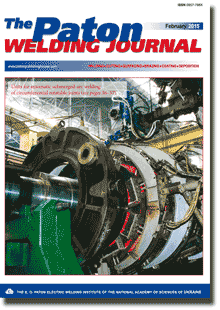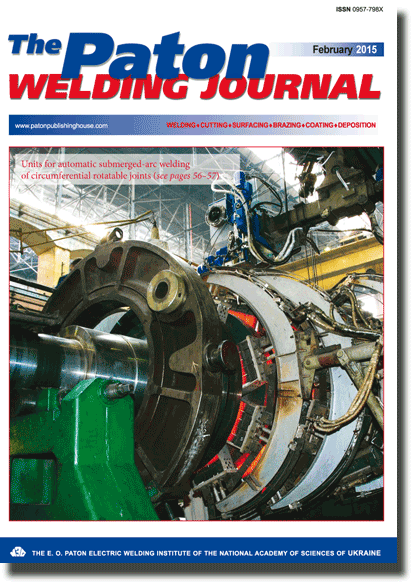| 2015 №02 (02) |
DOI of Article 10.15407/tpwj2015.02.03 |
2015 №02 (04) |

The Paton Welding Journal, 2015, #2, 14-18 pages
EFFECT OF TITANIUM-CONTAINING INOCULANTS ON STRUCTURE AND PROPERTIES OF WELD METAL OF HIGH-STRENGTH LOW-ALLOY STEELS
V.V. Golovko, S.N. Stepanyuk And D.Yu. Ermolenko
E.O. Paton Electric Welding Institute, NASU. 11 Bozhenko Str., 03680, Kiev, Ukraine. E-mail: office@paton.kiev.ua
Abstract
There is a necessity in increase of toughness and ductility indices of weld metal of high-strength low-alloy steels. Effect of inoculants on process of solidification and formation of grains of primary structure is not studied enough. Possibility of regulation of grain size of primary weld metal structure by weld metal melt inoculation with refractory titanium compounds, included into flux-cored wire was considered. Distribution of non-metallic inclusions in weld metal on size and morphology was investigated. Examinations of primary and secondary weld metal structure were carried out. It is determined that entering of titanium refractory compounds into the weld pool allows changing the size of primary structure dendrites. It was found that presence of titanium compounds having poor wetting by liquid iron (TiN) at interface results in blocking of dendrite growth. At the same time, introduction of titanium compounds characterized by small liquid iron wetting angles (TiC), in the melt promotes for formation of coarser dendrites. It was shown that weld metal with bainite (TiN) or ferrite (TiC) secondary structures, which are close on strength indices but differ on ductility and toughness levels, can be obtained depending on inoculant structure. Obtained results are realized in technology for welding of HSLA steels using flux-cored wire with titanium-containing inoculants. Technology has passed experimental-industrial verification at Novo-Kramatorsk Machine-Building Works. 7 Ref., 5 Tables, 5 Figures.
Keywords: arc welding, low-alloy steels, flux-cored wire, introduction of titanium-containing inoculants, weld metal, structure and properties
Received: 23.12.14
Published: 01.04.15
References
1. Lee, T.-K., Kim, H.J., Kang, B.Y. et al. (2000) Effect of inclusion size on the nucleation of acicular ferrite in welds. ISIJ Int., 40(12), 1260-1268. https://doi.org/10.2355/isijinternational.40.1260
2. Oh, Y.J., Lee, S.-Y., Byun, J.-S. (2000) Non-metallic inclusions and acicular ferrite in low carbon steel. Materials Transact., 41(12), 1663-1669. https://doi.org/10.2320/matertrans1989.41.1663
3. Babu, S.S. (2004) The mechanism of acicular ferrite formation in weld deposits. Current Opinion in SolidState and Materials Sci., 8, 267-278. https://doi.org/10.1016/j.cossms.2004.10.001
4. Zhang, L., Thomas, B. (2006) State of the art in the control of inclusions during steel ingot casting. Metallurg. and Materials Transact., 37(5), 733-761. https://doi.org/10.1007/s11663-006-0057-0
5. Vanovsek, W., Bernhard, C., Fiedler, M. et al. Influence of alloying additions on the morphology of non-metallic inclusions in high-strength steel welds. IIW Doc. II-1776-11 (II-C-421-11).
6. Lyakishev, N.P., Pliner, Yu.L., Lappo, S.I. (1985) Alloys and steels doped with titanium. Moscow: Metallurgiya.
7. ISO 26304:2011: Welding consumables. - Solid wire electrodes, tubular cored electrodes and electrode-flux combinations for submerged arc welding of high strength steels. - Classification.
Suggested Citation
V.V. Golovko, S.N. Stepanyuk And D.Yu. Ermolenko (2015) Effect of titanium-containing inoculants on structure and properties of weld metal of high-strength low-alloy steels. The Paton Welding J., 02, 14-18.The cost of subscription/purchase order journals or individual articles
| Journal/Currency | Annual Set | 1 issue printed |
1 issue |
one article |
| TPWJ/USD | 384 $ | 32 $ | 26 $ | 13 $ |
| TPWJ/EUR | 348 € | 29 € | 24 € | 12 € |
| TPWJ/UAH | 7200 UAH | 600 UAH | 600 UAH | 280 UAH |
| AS/UAH | 1800 UAH | 300 UAH | 300 UAH | 150 UAH |
| AS/USD | 192 $ | 32 $ | 26 $ | 13 $ |
| AS/EUR | 180 € | 30 € | 25 € | 12 € |
| SEM/UAH | 1200 UAH | 300 UAH | 300 UAH | 150 UAH |
| SEM/USD | 128 $ | 32 $ | 26 $ | 13 $ |
| SEM/EUR | 120 € | 30 € | 25 € | 12 € |
| TDNK/UAH | 1200 UAH | 300 UAH | 300 UAH | 150 UAH |
| TDNK/USD | 128 $ | 32 $ | 26 $ | 13 $ |
| TDNK/EUR | 120 € | 30 € | 25 € | 15 € |
AS = «Automatic Welding» - 6 issues per year;
TPWJ = «PATON WELDING JOURNAL» - 12 issues per year;
SEM = «Electrometallurgy Today» - 4 issues per year;
TDNK = «Technical Diagnostics and Non-Destructive Testing» - 4 issues per year.


